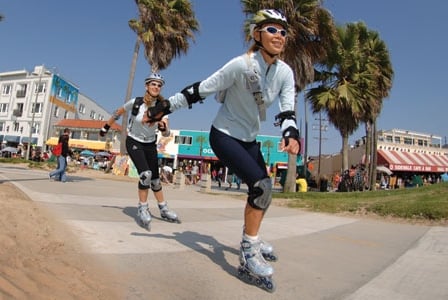
Inline skating is a great aerobic workout that the entire family can use to help stay in shape. Some people enjoy taking long leisurely skates, while others use inline skating for intense cardiovascular training or as a mode of transportation on city streets.
Inline skating is a great aerobic workout that the entire family can use to help stay in shape. Some people enjoy taking long leisurely skates, while others use inline skating for intense cardiovascular training or as a mode of transportation on city streets.
Whichever way you choose to roll, you can guarantee that you are getting a great workout. You will build strength in muscles in the upper leg, buttocks, hip, and lower back. A study conducted in 1991 at the Human Performance Laboratory at St. Cloud State University in Minnesota found that swinging your arms vigorously during skating also builds muscles in the shoulders and upper arms.
According to Dr. Carl Foster, associate professor of medicine at the University of Wisconsin Medical School and coordinator of sports medicine and sports science for the US Speed Skating Team, inline skating burns as many calories as running.
A 1997 University of Massachusetts fitness study found that inline skating causes 50 percent less impact shock to the joints when compared to running. This means you’ll be able to stay active longer without the risk of long-term injury. It also means inline skating is a great way to stay active when sore knees and joints keep you out of your running shoes and off the trail.
Skate Safely
As in all sports, it is important to approach inline skate with caution. This means wearing a helmet and protective gear while skating. Protective gear consists of elbow pads, knee pads, and wrist guards, available for purchase anywhere you buy skates. A helmet and protective gear will help you feel safe and build your confidence, especially if you are just learning how to skate.
If you happen to be starting out, community centres and some skate shops offer lessons with qualified professionals who will teach you how to skate and stop properly. If you have difficulty finding these services in your region, go to your local inline skate dealer or visit freeskatelesson.com to find a professional instructor.
The Right Gear
Another important factor with skating is making sure you have the right equipment. Inline skates include a vast range of products, so when you are looking for a skate, it is important to know exactly how you plan to use them. Is your goal to blade marathon races? Then you should choose a race-specific product. Are you trying to improve your overall physical fitness? Then choose a fitness skate. Do you want to have fun with family and friends at a leisurely pace? Then choose a recreational skate. Each type of inline skate is made using specific technology to optimize your performance and comfort level.
Skating should be fun and easy. Follow these steps and you will be on your way to happy rolling.
How It All Began
Rollerblade was established in 1980 by two hockey-playing brothers in Minnesota. In order to keep up their hockey skills during the summer months, they redesigned the roller skate, which has two wheels in side-by-side pairs, and reattached the wheels in a single line. This change allowed the brothers to skate in the same way they did on ice. They also added a brake at the back of the skate to allow skaters to stop and turn quickly, a necessary skill for hockey play.
Burn It, Baby
During a 30-minute period, inline skating at a steady, comfortable pace burns 285 calories. Interval skating, alternating one minute of hard skating in a tuck position with one minute of easy skating in an upright position, burns more than 450 calories in the same 30 minutes. Depending how hard you work, running and cycling expend about 350 and 360 calories for
30 minutes.
Source: rollerblade.com
Try Roller Hockey
Roller hockey is a great alternative to ice hockey. Games are played four on four, with no body checking, icing, or offsides. The cost outlay is also lower because roller hockey players require less equipment to protect themselves–the puck is plastic rather than hard rubber. Many ice hockey players play roller hockey in the off-season or in addition to their on-ice play. For more information or to find a roller hockey league near you, visit the website of the National Inline Hockey Association at niha.ca.
















